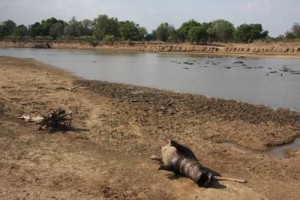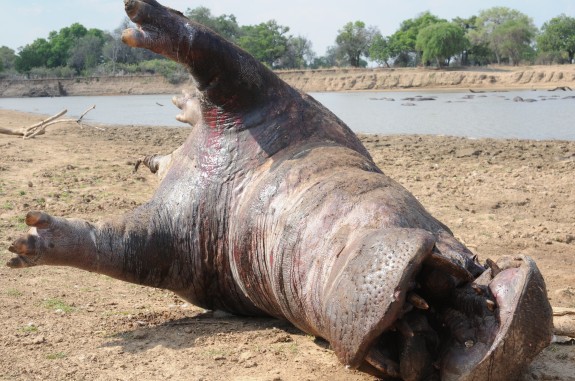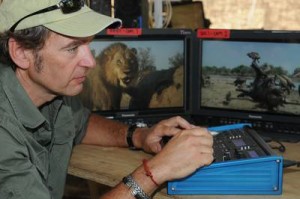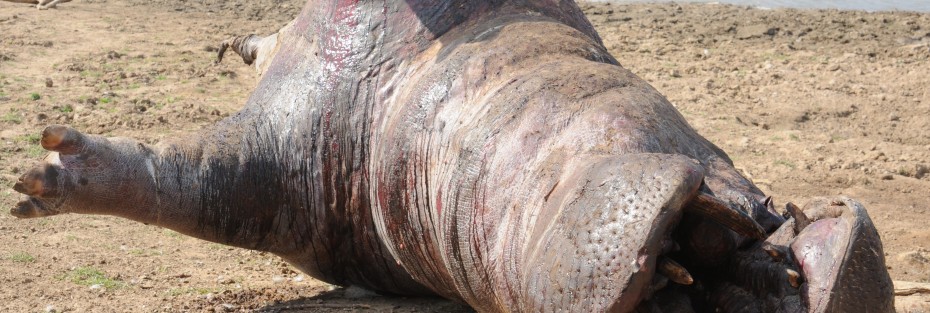Animal Planet explores the aftermath of a hippo’s death in new documentary

Typically, wildlife TV shows love to show the inherent majesty of the world’s animal kingdom. Raptors flying through the sky, talons ready to catch some fish. Great white sharks jumping out of the waters off the coast of South Africa. Lions stalking their prey in the hot, hot temperatures.
A new Animal Planet documentary, Eating Giants: Hippo, takes the opposite approach. Rather than showcasing life, the documentary displays what happens when a big animal dies on the banks of a river. Can a hippopotamus carcass provide new life?
The one-hour special, set to air Sunday, Sept. 16 at 10 p.m., dives right into the food chain, showing nature’s dependence on the environment and other species. Recently, Hollywood Soapbox exchanged e-mails with the executive producers of Eating Giants: Hippo, including Dick Colhurst from Tigress Productions and Erin Wanner from Animal Planet.
How did Animal Planet and yourself find this story?
Colhurst: The idea came while walking my dog. I’d just read an article in a newspaper where the writer had visited some famous bat caves in Borneo and was amazed to see insects living off the pungent guano on the cave floor and wasn’t the food chain an amazing thing. As I walked my dog, I was wondering about how you could scale that up. An elephant and then a hippo were the obvious choices. What eats a hippo was a question that intrigued everyone but nobody seemed to know the answer so we set about finding out.
Wanner: Tigress came to us at Animal Planet with the idea right as we were looking for new stories to tell in the natural history space and ways to reimagine how those stories could be told. Eating Giants fit the bill on both counts.

Watching the final stages of a hippo is a pretty unique angle for a special. Why is this story important for our understanding of the animal kingdom?
Colhurst: It’s all about the circle of life and how animals that spend their lives at the top of the food chain inevitably become the bottom when they die. The millions of calories stored up in a giant animal over its lifetime are recycled in a matter of days in a vivid demonstration of the law of physics that states energy can neither be created nor destroyed. Animals have to die so that others can survive.
Wanner: The “cycle of life” story has been told, of course and everyone understand(s) the essential nature of the food chain, but no one had ever used television to really get in there and examine how many different forms of life sustain themselves on a single carcass. And then to be bold enough to show this process so unflinchingly, and in real time — we just thought it was such a brilliant and exciting idea, and one that would reveal things about this process that even surprised the scientists on camera.
What were some of the challenges of shooting the special?
Colhurst: This was a high risk production made in a very remote part of Africa at the height of the dry season in extreme heat. There were no guarantees of success and equipment failures were a constant problem. Ground temperatures of more than 60°C pushed the crew and equipment to breaking point, and the remote control cameras had to be turned off during the heat of the day to prevent further damage to the electrics while replacement equipment was flown in from the UK. A 20-strong production and scientific team set up in a studio tent 200 (meters) from the carcass to monitor the cameras and film the expert analysis, but nobody knew if the experiment would work and that scavengers would actually come to the carcass. As it turned out we had no need to worry, but it was genuinely nerve-wracking for the first few days.
Wanner: The phenomenal Tigress team were really the ones on the ground facing the challenges of shooting the special and all we could do was support them from afar, but there were challenges for us as well. The first was convincing everyone at the network that viewers would want to watch a special about a decomposing hippo. We were gratified at how readily everyone here at Animal Planet took on that risk, and if the ratings success of these specials in the UK are any predictor, the risk will (be) well rewarded. And then of course we too had to cross our fingers that it would all work and that the animals would show up! Dick and his team executed this enormously challenging production flawlessly and happily for us, nature complied!

Do you believe hippos are misunderstood in our culture? They are often seen as violent, harmful creatures.
Colhurst: Not really — they ARE extremely dangerous animals and the hippo used in the filming had been shot by the Zambian wildlife authorities because it had become a danger to local villagers.
Wanner: I agree with Dick that the danger to humans posed by hippos when we are in their environment cannot be overstated, but certainly if there was no need for humans and hippos to interact, they could not be described as “harmful.” If anything, I do think certain animated films and television in our culture project an image of hippos as friendly, which one could make the case is a dangerous misperception to perpetuate.
Were you and the team surprised by the number and variety of animals that feasted on the hippo?
Colhurst: The carcass attracted all the predators and scavengers we hoped, even if we were a bit disappointed that neither the lion or the leopard that visited actually ate from the carcass. The big surprise to everyone, including the croc expert, was the sheer number of crocodiles and the size of some of them. None of our experts had ever witnessed interaction between crocodiles and hyenas on a carcass and further scientific research projects have been proposed to follow up discoveries made during the course of the shoot.
Wanner: Animal Planet was thrilled by the number and variety of the animals that showed up to the hippo carcass, and the crocodile sequences that Dick describes above gave me goosebumps to watch. Watching in real time as the crocodiles move, en masse, slowly but purposefully up to the carcass and the way (they) scare off the pack of hyenas is extraordinary. And then of course, there’s the moment a crocodile finally is the first to penetrate the exceedingly tough hippo hide — a truly YouTube moment! We hope everyone will tune in to check out this unique and fascinating special.
By John Soltes / Publisher / John@HollywoodSoapbox.com
-
Eating Giants: Hippo airs Sunday, Sept. 16 at 10 p.m. on Animal Planet.

